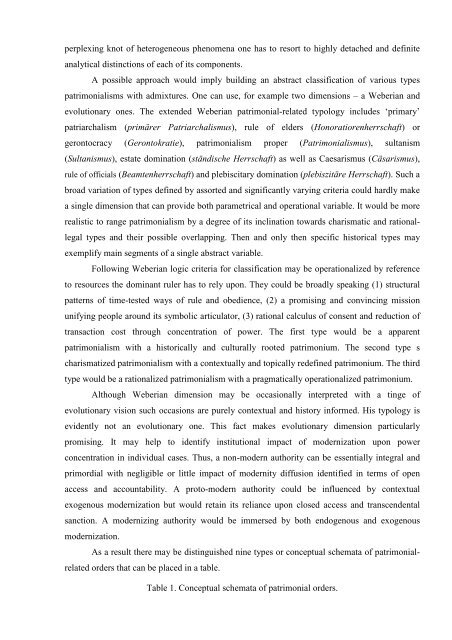Ilyin patrimonialism rediscriptions
Ilyin patrimonialism rediscriptions
Ilyin patrimonialism rediscriptions
You also want an ePaper? Increase the reach of your titles
YUMPU automatically turns print PDFs into web optimized ePapers that Google loves.
perplexing knot of heterogeneous phenomena one has to resort to highly detached and definite<br />
analytical distinctions of each of its components.<br />
A possible approach would imply building an abstract classification of various types<br />
<strong>patrimonialism</strong>s with admixtures. One can use, for example two dimensions – a Weberian and<br />
evolutionary ones. The extended Weberian patrimonial-related typology includes ‘primary’<br />
patriarchalism (primärer Patriarchalismus), rule of elders (Honoratiorenherrschaft) or<br />
gerontocracy (Gerontokratie), <strong>patrimonialism</strong> proper (Patrimonialismus), sultanism<br />
(Sultanismus), estate domination (ständische Herrschaft) as well as Caesarismus (Cäsarismus),<br />
rule of officials (Beamtenherrschaft) and plebiscitary domination (plebiszitäre Herrschaft). Such a<br />
broad variation of types defined by assorted and significantly varying criteria could hardly make<br />
a single dimension that can provide both parametrical and operational variable. It would be more<br />
realistic to range <strong>patrimonialism</strong> by a degree of its inclination towards charismatic and rationallegal<br />
types and their possible overlapping. Then and only then specific historical types may<br />
exemplify main segments of a single abstract variable.<br />
Following Weberian logic criteria for classification may be operationalized by reference<br />
to resources the dominant ruler has to rely upon. They could be broadly speaking (1) structural<br />
patterns of time-tested ways of rule and obedience, (2) a promising and convincing mission<br />
unifying people around its symbolic articulator, (3) rational calculus of consent and reduction of<br />
transaction cost through concentration of power. The first type would be a apparent<br />
<strong>patrimonialism</strong> with a historically and culturally rooted patrimonium. The second type s<br />
charismatized <strong>patrimonialism</strong> with a contextually and topically redefined patrimonium. The third<br />
type would be a rationalized <strong>patrimonialism</strong> with a pragmatically operationalized patrimonium.<br />
Although Weberian dimension may be occasionally interpreted with a tinge of<br />
evolutionary vision such occasions are purely contextual and history informed. His typology is<br />
evidently not an evolutionary one. This fact makes evolutionary dimension particularly<br />
promising. It may help to identify institutional impact of modernization upon power<br />
concentration in individual cases. Thus, a non-modern authority can be essentially integral and<br />
primordial with negligible or little impact of modernity diffusion identified in terms of open<br />
access and accountability. A proto-modern authority could be influenced by contextual<br />
exogenous modernization but would retain its reliance upon closed access and transcendental<br />
sanction. A modernizing authority would be immersed by both endogenous and exogenous<br />
modernization.<br />
As a result there may be distinguished nine types or conceptual schemata of patrimonialrelated<br />
orders that can be placed in a table.<br />
Table 1. Conceptual schemata of patrimonial orders.
















